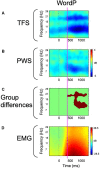The Application of EEG Mu Rhythm Measures to Neurophysiological Research in Stuttering
- PMID: 31998103
- PMCID: PMC6965028
- DOI: 10.3389/fnhum.2019.00458
The Application of EEG Mu Rhythm Measures to Neurophysiological Research in Stuttering
Abstract
Deficits in basal ganglia-based inhibitory and timing circuits along with sensorimotor internal modeling mechanisms are thought to underlie stuttering. However, much remains to be learned regarding the precise manner how these deficits contribute to disrupting both speech and cognitive functions in those who stutter. Herein, we examine the suitability of electroencephalographic (EEG) mu rhythms for addressing these deficits. We review some previous findings of mu rhythm activity differentiating stuttering from non-stuttering individuals and present some new preliminary findings capturing stuttering-related deficits in working memory. Mu rhythms are characterized by spectral peaks in alpha (8-13 Hz) and beta (14-25 Hz) frequency bands (mu-alpha and mu-beta). They emanate from premotor/motor regions and are influenced by basal ganglia and sensorimotor function. More specifically, alpha peaks (mu-alpha) are sensitive to basal ganglia-based inhibitory signals and sensory-to-motor feedback. Beta peaks (mu-beta) are sensitive to changes in timing and capture motor-to-sensory (i.e., forward model) projections. Observing simultaneous changes in mu-alpha and mu-beta across the time-course of specific events provides a rich window for observing neurophysiological deficits associated with stuttering in both speech and cognitive tasks and can provide a better understanding of the functional relationship between these stuttering symptoms. We review how independent component analysis (ICA) can extract mu rhythms from raw EEG signals in speech production tasks, such that changes in alpha and beta power are mapped to myogenic activity from articulators. We review findings from speech production and auditory discrimination tasks demonstrating that mu-alpha and mu-beta are highly sensitive to capturing sensorimotor and basal ganglia deficits associated with stuttering with high temporal precision. Novel findings from a non-word repetition (working memory) task are also included. They show reduced mu-alpha suppression in a stuttering group compared to a typically fluent group. Finally, we review current limitations and directions for future research.
Keywords: basal ganglia; internal models; mu rhythm; sensorimotor integration; speech perception; speech production; stuttering; working memory.
Copyright © 2020 Jenson, Bowers, Hudock and Saltuklaroglu.
Figures







Similar articles
-
EEG Mu (µ) rhythm spectra and oscillatory activity differentiate stuttering from non-stuttering adults.Neuroimage. 2017 Jun;153:232-245. doi: 10.1016/j.neuroimage.2017.04.022. Epub 2017 Apr 9. Neuroimage. 2017. PMID: 28400266 Free PMC article.
-
Trait related sensorimotor deficits in people who stutter: An EEG investigation of μ rhythm dynamics during spontaneous fluency.Neuroimage Clin. 2018 May 21;19:690-702. doi: 10.1016/j.nicl.2018.05.026. eCollection 2018. Neuroimage Clin. 2018. PMID: 29872634 Free PMC article.
-
The Effects of Fluency Enhancing Conditions on Sensorimotor Control of Speech in Typically Fluent Speakers: An EEG Mu Rhythm Study.Front Hum Neurosci. 2018 Apr 4;12:126. doi: 10.3389/fnhum.2018.00126. eCollection 2018. Front Hum Neurosci. 2018. PMID: 29670516 Free PMC article.
-
Phonological working memory in developmental stuttering: Potential insights from the neurobiology of language and cognition.J Fluency Disord. 2018 Dec;58:94-117. doi: 10.1016/j.jfludis.2018.08.006. Epub 2018 Sep 1. J Fluency Disord. 2018. PMID: 30224087 Review.
-
The Role of Basal Ganglia and Its Neuronal Connections in the Development of Stuttering: A Review Article.Cureus. 2022 Aug 31;14(8):e28653. doi: 10.7759/cureus.28653. eCollection 2022 Aug. Cureus. 2022. PMID: 36196326 Free PMC article. Review.
Cited by
-
Exploring EEG Responses during Observation of Actions Performed by Human Actor and Humanoid Robot.Proc IEEE RAS EMBS Int Conf Biomed Robot Biomechatron. 2024 Sep;2024:1795-1801. doi: 10.1109/biorob60516.2024.10719790. Epub 2024 Oct 23. Proc IEEE RAS EMBS Int Conf Biomed Robot Biomechatron. 2024. PMID: 40756697 Free PMC article.
-
Enhanced Recognition of Amputated Wrist and Hand Movements by Deep Learning Method Using Multimodal Fusion of Electromyography and Electroencephalography.Sensors (Basel). 2022 Jan 16;22(2):680. doi: 10.3390/s22020680. Sensors (Basel). 2022. PMID: 35062641 Free PMC article.
-
Investigating mu and alpha oscillations as indicators of intra-individual success and inter-individual ability in motor imagery performance.Front Psychol. 2025 Jun 25;16:1598196. doi: 10.3389/fpsyg.2025.1598196. eCollection 2025. Front Psychol. 2025. PMID: 40636037 Free PMC article.
-
Dissecting structural connectivity of the left and right inferior frontal cortex in children who stutter.Cereb Cortex. 2023 Mar 21;33(7):4085-4100. doi: 10.1093/cercor/bhac328. Cereb Cortex. 2023. PMID: 36057839 Free PMC article.
-
Psychedelics in developmental stuttering to modulate brain functioning: a new therapeutic perspective?Front Hum Neurosci. 2024 Jun 19;18:1402549. doi: 10.3389/fnhum.2024.1402549. eCollection 2024. Front Hum Neurosci. 2024. PMID: 38962146 Free PMC article.
References
Grants and funding
LinkOut - more resources
Full Text Sources
Research Materials
Miscellaneous

